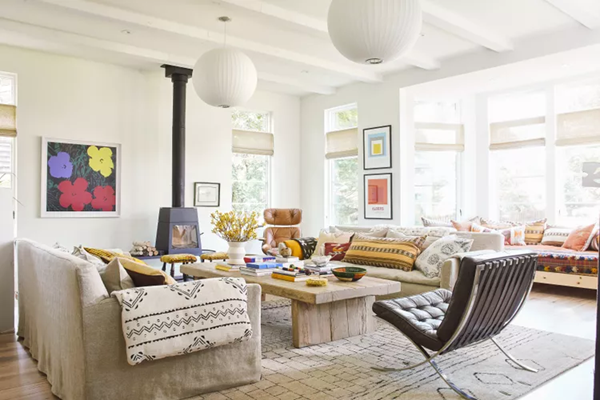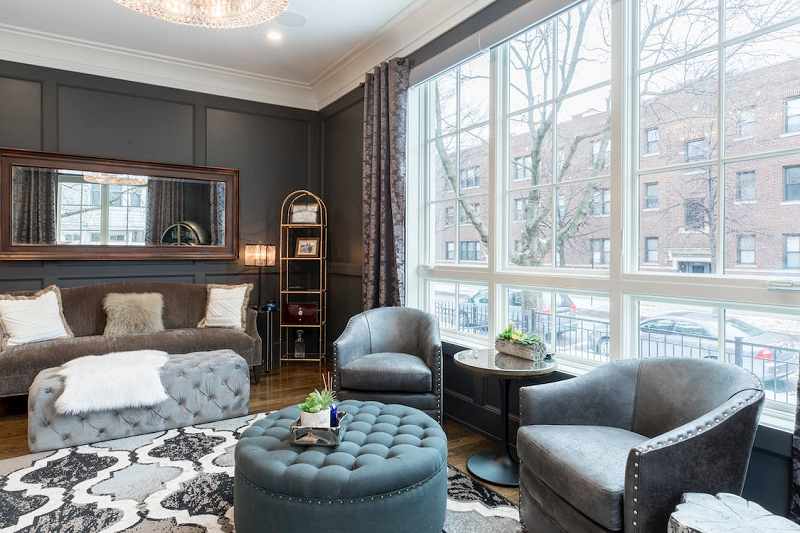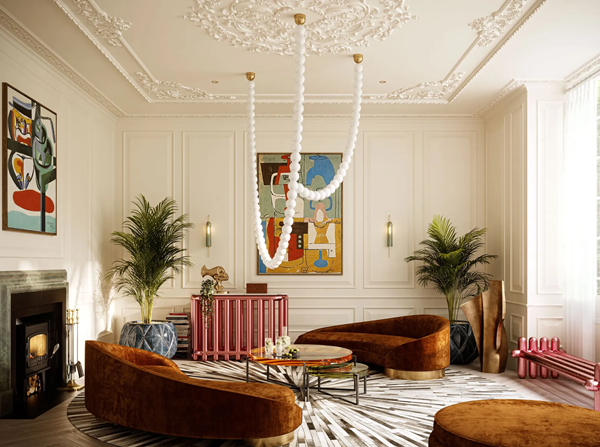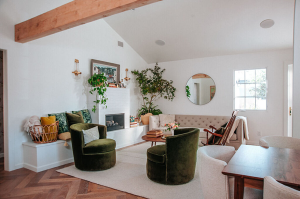Color plays a profound role in how to choose colors for a room and helps you shape the atmosphere of your living spaces. From evoking feelings of calm and relaxation to boosting creativity and energy, the right color palette can transform a room into a reflection of your personality and style.
But with countless paint shades and conflicting advice, navigating the world of color can feel overwhelming. This guide will equip you with the knowledge and tools you need to conquer the color conundrum and create a space that sparks joy and inspires you every day.

Have you dreamt of a bedroom bathed in serene blues that lull you to sleep? Or perhaps a kitchen brimming with vibrant hues that ignite your culinary spirit? This begins with understanding the power of color and its impact on mood and function. We’ll delve into color theory, explore different style palettes, and discover tips for choosing colors that complement your existing décor and natural light.
Whether you’re a seasoned color enthusiast or a nervous newbie, this guide will empower you to unleash your inner colorist and create a home that truly reflects your unique personality and lifestyle. So, I’m about to unlock the secrets of how to choose colors for a room that speaks to your soul through the captivating language of color.
Demystifying Color: A Foundation for Your Color Palette

Before choosing colors for a room, it’s crucial to understand the fundamental building blocks of color theory. This knowledge will serve as your compass, guiding you through the vast landscape of hues and ensuring your chosen colors harmoniously coexist.
“If you are looking for a way to style your space with wall art without breaking your piggy bank, then I recommend reading “10 Surprising Benefits of Printable Wall Art”
1. Color Wheel: Your Navigational Guide:
Imagine a vibrant wheel divided into twelve sections, each representing a distinct color. This is the color wheel, and it serves as a powerful tool for understanding color relationships. The wheel reveals complementary colors that sit opposite each other, creating a vibrant contrast. Analogous colors, positioned side-by-side, offer a sense of coherence and flow. Triadic harmonies are formed by selecting three equidistant colors, resulting in a dynamic and playful composition. Understanding these relationships will equip you to create balanced and aesthetically pleasing color schemes for your room.
2. The Power of Hues, Saturation, and Value:
While navigating the color wheel is essential, understanding the interplay of hue, saturation, and value is equally important.
- Hue refers to the actual color itself, the pure pigment unadulterated with white or black.
- Saturation describes the intensity or vibrancy of the hue. Highly saturated colors appear bold and vivid, while desaturated colors are muted and subdued.
- Value refers to the lightness or darkness of a color. Lighter values are associated with airiness and spaciousness, while darker values convey a sense of warmth and intimacy.
Mastering these concepts empowers you to manipulate color to create depth, dimension, and a harmonious flow in your chosen space.
3. Light and Its Impact:
Natural light plays a crucial role in how colors appear within your room. North-facing rooms receive cooler light, making them ideal for warm colors to add vibrancy. Conversely, south-facing rooms are bathed in warm light, benefitting from cooler colors to balance the temperature. Understanding the impact of light will help you choose colors that flatter your room and create a comfortable and inviting atmosphere.
By exploring the intricacies of color theory, light, and their relationship to your chosen space, you’ll gain invaluable knowledge to confidently choose the right colors for your room and unlock a world of creative possibilities.
Also: The Rule Of Three For Decorating Your Home
Defining Your Style: A Palette for Your Personality

Now that you’re equipped with the fundamental principles of color theory, let’s move forward and embark on a self-discovery journey to unlock your personal style. Understanding your aesthetic preferences is paramount to choosing colors that resonate with your personality and create a space that feels truly like home.
“Personal style is like a fingerprint – unique, evolving, and deeply personal. Your home should be a reflection of that, with your color palette serving as the foundation. Look to experiences, travels, and memories that inspire you, and don’t be afraid to experiment! Bold choices can tell a captivating story about who you are.”
– Justina Blakeney
1. Embracing Your Style DNA:
Do you gravitate towards classic and timeless design? Or perhaps you’re drawn to the modern and minimalist aesthetic? Reflecting on your existing furniture, artwork, and personal possessions can offer valuable insights into your style preferences. Consider the colors that already exist in your living space and determine whether they create a harmonious flow or evoke conflicting emotions.
2. Exploring Style Archetypes:
To further refine your understanding of personal style, delve into established design archetypes. Explore various styles like Scandinavian, Mid-century Modern, Boho Chic, or Industrial. Look for recurring color palettes and elements that resonate with your taste. This exploration can serve as inspiration and provide concrete examples to guide your color choices.
3. Experimenting with Color Palettes:
Once you’ve identified your style inclinations, it’s time to dive into the world of color palettes. Websites, magazines, and color apps offer an abundance of inspiration. Experiment with different color combinations, keeping your style preferences and room function in mind. Play with online tools that allow you to visualize your chosen colors in a virtual room, providing a realistic preview of your potential space.
4. Unleashing Your Inner Artist:
Don’t be afraid to step outside the box and experiment with bold color combinations. Remember, there are no rigid rules when it comes to color. Choose colors that evoke emotions, memories, and inspire you. Trust your intuition and allow your creativity to guide you in creating a space that reflects your unique personality.
By exploring all the color palettes you’ll choosing colors for your room that resonate with your soul and create a space that truly reflects your personal style and brings joy to your everyday life.
Also: How To Create a Dining Room Gallery Wall
Function Meets Form: Choosing Colors for Your Room’s Purpose

With your personal style firmly established and color theory under your belt, it’s time to consider the functional role of your room. Choosing colors that complement the purpose and activity level of your space is crucial for creating a harmonious and comfortable environment.
Also: How To Find Your Interior Design Style: A Step By Step Guide
1. Matching Colors to Function:
- Bedrooms: Opt for calming and relaxing colors like blues, greens, and grays to promote restful sleep and a peaceful environment.
- Living rooms: Consider warm and inviting colors like yellows, oranges, and reds to foster a sense of conviviality and encourage conversation and interaction.
- Kitchens: Choose colors that are both stimulating and functional, such as yellows, light greens, and blues, to create an uplifting and energetic space for culinary creativity.
- Home offices: Opt for colors that promote focus and concentration, such as blues, greens, and grays, to create a productive and tranquil environment.
2. Balancing Light and Space:
Utilize color to manipulate the perceived size and feel of your room. Lighter colors like whites, beiges, and pastels can make a small space feel more spacious and airy. Conversely, darker colors like browns, grays, and blues can create a sense of intimacy and coziness in a large room.
3. Existing Decor and Architectural Elements:
Consider the existing furniture, flooring, and architectural elements within your room. Choose colors that complement these elements and create a cohesive visual flow. Avoid clashing colors and strive for a harmonious balance between all design components.
4. Creating Focal Points:
Use color strategically to highlight specific areas within your room. Opt for a bold accent wall to draw attention to a fireplace or create a visual focal point. Utilize contrasting colors to emphasize architectural features like columns or bookshelves.
By thoughtfully considering the function of your room and existing elements, you can choose colors that enhance its purpose and create a truly functional and visually pleasing space.
Also: How to Design a Man Cave That Rocks
Putting Your Palette into Practice: Applying Color to Your Room

With your foundation of color theory, personal style, and room function firmly established, it’s time to put your knowledge into action and transform your vision into reality. This section will guide you through the practical process of applying your chosen color palette to your room.
“Color has the power to transform a space in an instant. But remember, your home is not a magazine spread; it’s a place to live and feel good in. Start small, experiment with accents, and don’t be afraid to break the rules! Trust your gut, embrace intuition, and let your chosen colors tell your personal story.”
– Kelly Hoppen, renowned interior designer
1. Selecting the Perfect Paint:
Paint is the lifeblood of any color transformation. Research reputable paint brands and choose high-quality finishes that suit your needs. Consider factors like durability, stain resistance, and light reflection when making your selection.
2. Sample Savvy:
Don’t underestimate the power of paint samples! Before committing to a full room transformation, purchase samples of your chosen colors and test them on different walls at various times of the day. Observe how the light interacts with each color and ensure they harmonize with your existing décor.
3. The Rule of Three:
When selecting colors for your room, adhere to the “rule of three.” This design principle suggests using three primary colors: a dominant color, a secondary color, and an accent color. This approach ensures balance, visual interest, and a cohesive overall design.
4. Accentuate with Accessories:
Once your walls are painted, don’t forget the power of accessories! Throw pillows, rugs, artwork, and other decorative elements can be used to tie your color scheme together and personalize your space. Choose accessories that complement your chosen colors and add pops of personality to your room.
5. Lighting and its Impact:
Remember, lighting plays a crucial role in how colors appear. Install dimmers to adjust the ambiance and ensure your chosen colors are showcased to their full potential. Consider adding additional lighting elements like lamps or sconces to highlight specific areas and create a layered effect.
6. Embrace the Unexpected:
Don’t be afraid to break the rules and embrace the unexpected! Experiment with different color combinations and textures to create a unique and personalized space. Trust your instincts and let your creativity guide you in crafting a room that reflects your individuality and inspires you every day.
By following these steps and embracing your creative spirit, you can confidently apply your chosen color palette to your room and witness the transformative power of color in creating a space that is both beautiful and functional.
Also: How To Decorate a Desk at Home
Beyond the Basics: Advanced Tips for Mastering Color

Having successfully navigated the fundamentals of color selection and application, let’s delve deeper into how to choose colors for a room, exploring advanced techniques and tips to elevate your room’s ambiance and express your unique style.
“Mastering wall color is about understanding space, light, and the psychology of color. Consider the orientation of your living room, how natural light interacts with different hues, and what emotions you want to evoke. Don’t be afraid to try bold accents, but remember balance is key. Experiment with samples, trust your instincts, and don’t be afraid to seek professional guidance if needed. Remember, your walls are a canvas – paint your personality onto them!”
– Kelly Wearstler
1. Harnessing the Power of Contrast:
Contrast plays a vital role in creating visual interest and depth within your space. Utilize contrasting colors to highlight architectural features, furniture, or artwork. Experiment with various color temperatures, such as warm and cool tones, to create a dynamic and engaging visual experience.
2. Mastering the Monochromatic Dream:
Monochromatic color schemes, utilizing various shades of a single hue, can create a serene and sophisticated atmosphere. Explore the subtle variations within your chosen color and use them to create depth and dimension. Don’t shy away from incorporating complementary colors as accents to add a touch of vibrancy and prevent the space from becoming monotonous.
3. Embracing Pattern and Texture:
Patterns and textures add another layer of visual complexity and interest to your room’s design. Experiment with patterned wallpapers, rugs, or throws to break up solid color and create a sense of movement and dynamism. Consider the scale and repetition of your chosen patterns to ensure they harmonize with the overall design and avoid visual clutter.
4. The Art of Layering:
Color layering allows you to create a richer and more nuanced palette within your space. Begin with a neutral base color and layer on accents of bolder hues through furniture, accessories, and artwork. This technique adds depth and visual interest while maintaining a sense of cohesion and balance.
5. The Psychology of Color:
Consider the psychological impact of color when making your choices. Cool blues and greens evoke feelings of calmness and tranquility, while warm yellows and oranges promote energy and stimulation. Choose colors that resonate with your desired mood and atmosphere for each room.
6. Seek Inspiration and Experimentation:
Don’t hesitate to draw inspiration from online resources, design magazines, and even nature. Experiment with different color combinations through visualization tools and paint samples before committing to a final color scheme. Embrace the process of experimentation and discovery to find the perfect palette that speaks to your soul.
By venturing beyond the basics and embracing these advanced techniques, you can unlock the full potential of color in your home, transforming ordinary spaces into extraordinary expressions of your personality and style.
Also: How to Pick a Front Door Color That Pops (and Sells!)
Most Popular Post:
10 Surprising Benefits of Printable Wall Art
How to Choose The Right TV Size to Decorate Your Living Room
The ultimate Smart Home Design Guide: Automate your life
Tips for Home Decorating on a Budget: Where to Splurge and Save
10 Best Couch Colors That Make a Room Look Bigger
Conclusion
Congratulations! You just learned how to choose colors for a room and how color has power to transform and shape your living spaces.
From delving into color theory and understanding its impact on mood and function to defining your personal style and choosing colors that resonate with your soul, you have acquired the knowledge and tools to create a home that reflects your unique personality and brings joy to your everyday life.
Remember, there are no rigid rules when it comes to color. Embrace your creativity, experiment with boldness, and trust your intuition. The journey of color is an ongoing exploration, a constant interplay between personal preference, design trends, and the ever-evolving landscape of your life and experiences.**
Here are some key takeaways to guide you on your continued color adventure:
- Color is a powerful tool: Use it to evoke emotions, create a desired atmosphere, and enhance the functionality of your space.
- Personal style is paramount: Choose colors that resonate with your unique personality and aesthetic preferences.
- Balance and harmony are key: Use the principles of color theory and design to create a cohesive and visually pleasing environment.
- Experimentation is essential: Don’t be afraid to try different color combinations and let your creativity flow.
- Seek inspiration and knowledge: Continuously learn about color trends, explore design resources, and draw inspiration from the world around you.
Embrace the journey of color. Let it be a canvas for your self-expression, a way to connect with your inner artist, and a tool to create a home that is both beautiful and functional, a true reflection of the unique individual you are.
FAQs: How To Choose Colors For a Room
1. I’m overwhelmed by all the paint colors! Where do I even start?
- Focus on your room’s purpose and desired atmosphere. Do you want a calming bedroom, an energetic kitchen, or a cozy living room? Choose colors that complement the function of the space.
- Consider your existing furniture and décor. Choose colors that harmonize with your existing elements to create a cohesive look.
- Don’t be afraid to experiment! Use online tools and paint samples to try out different color combinations before committing.
2. What are some foolproof color schemes for beginners?
- Monochrome: Choose different shades of a single color for a serene and sophisticated look.
- Analogous: Select colors that sit next to each other on the color wheel for a harmonious and natural feel.
- Complementary: Combine colors opposite each other on the color wheel for a vibrant and eye-catching contrast.
3. How can I make a small room feel bigger?
- Use lighter colors like whites, beiges, and pastels to reflect light and create an illusion of spaciousness.
- Avoid dark colors and heavy patterns that can visually shrink the space.
- Paint the ceiling a lighter color than the walls to draw the eye upwards.
4. What’s the best way to use accent walls?
- Choose an accent wall that draws attention to a specific architectural feature like a fireplace or alcove.
- Select an accent color that complements your main color scheme but adds a touch of contrast and personality.
- Use bold or patterned wallpaper for a dramatic statement wall in a smaller space.
5. How can I incorporate natural light into my color choices?
- North-facing rooms receive cooler light: Opt for warmer colors like yellows, oranges, and reds to balance the temperature.
- South-facing rooms receive warmer light: Choose cooler colors like blues, greens, and grays for a balanced look.
- Consider the angle and intensity of sunlight throughout the day to ensure your colors look their best.
6. What’s the difference between paint sheen levels?
- Flat or matte finishes are best for ceilings and low-traffic areas as they hide imperfections.
- Eggshell or satin finishes offer a balance between sheen and practicality, suitable for most walls.
- Semi-gloss or gloss finishes are ideal for high-traffic areas and kitchens as they reflect light and are easier to clean.
7. I’m worried about making a mistake! What should I do?
- Start with small areas first. Test paint samples on a hidden wall or piece of furniture before committing to the entire room.
- Seek advice from a professional designer or color consultant. They can help you create a personalized color scheme that fits your needs and style.
- Remember, there are no hard and fast rules in color! Experiment, have fun, and choose colors that you love.
CATCH THE LATEST IN HOME DECOR TRENDS:

Steal These 15 Expert-Approved Decorating Secrets

How To Accessories Your Living Room

Small Space? 10 Ways To Make A Room Appear Bigger

Make Your space Look Expensive
GET CAUGHT UP ON ALL THE INSPIRING DECOR TIPS:

18 Fresh Decorating Ideas To Update Your Fireplace

How To Create An Art Gallery Wall

